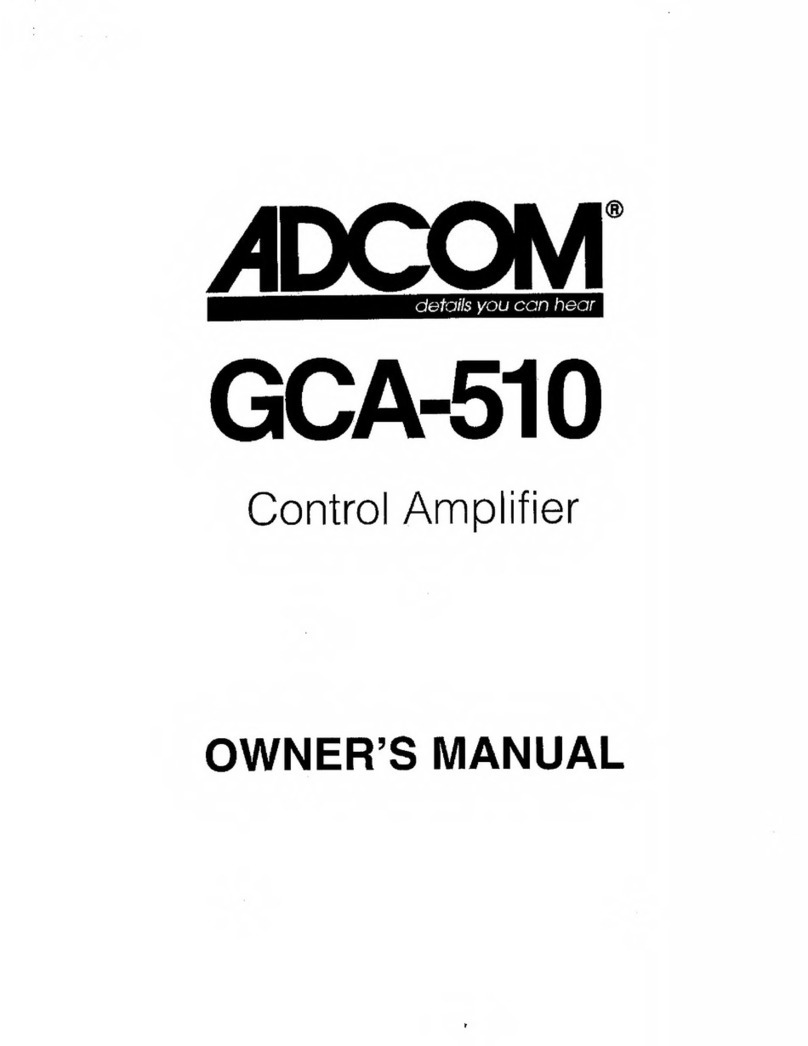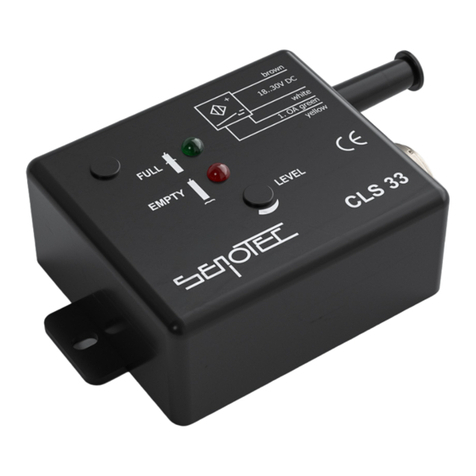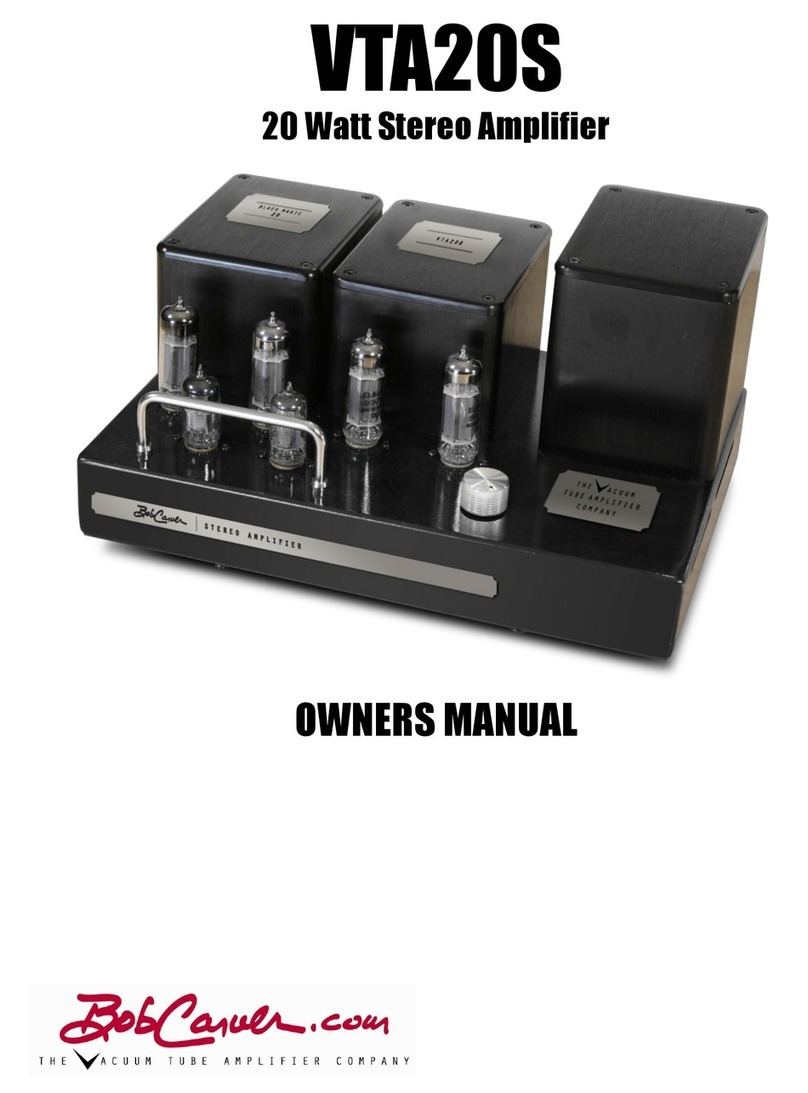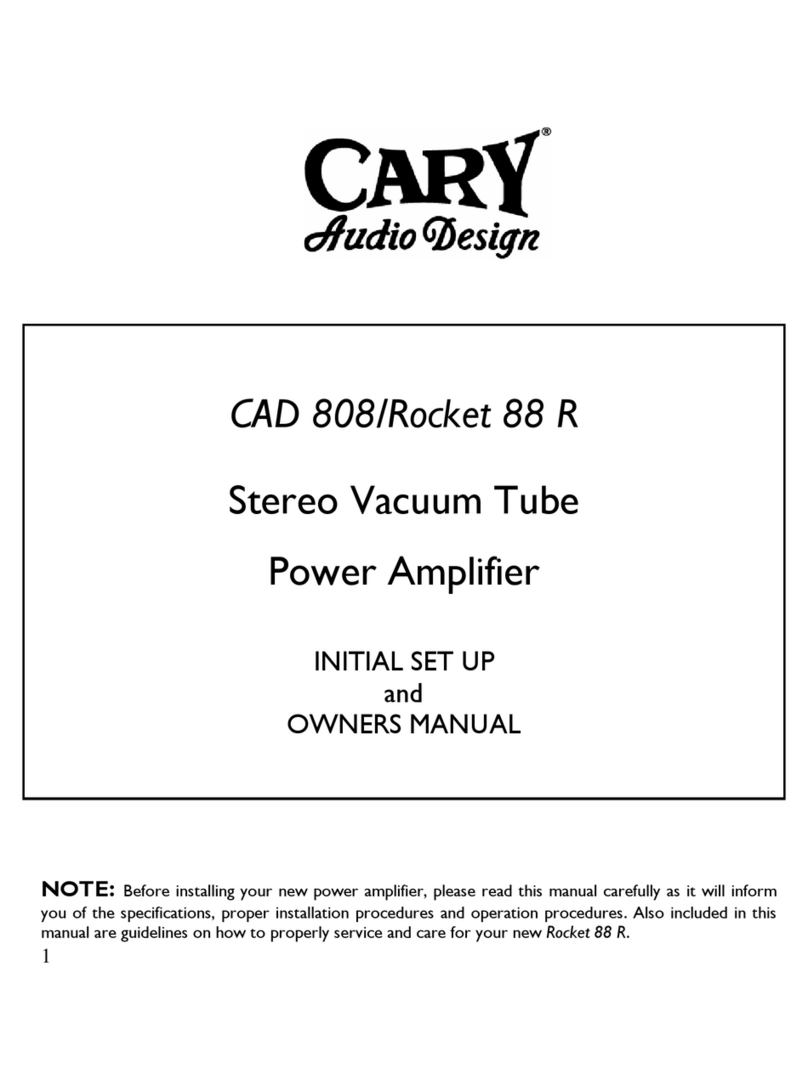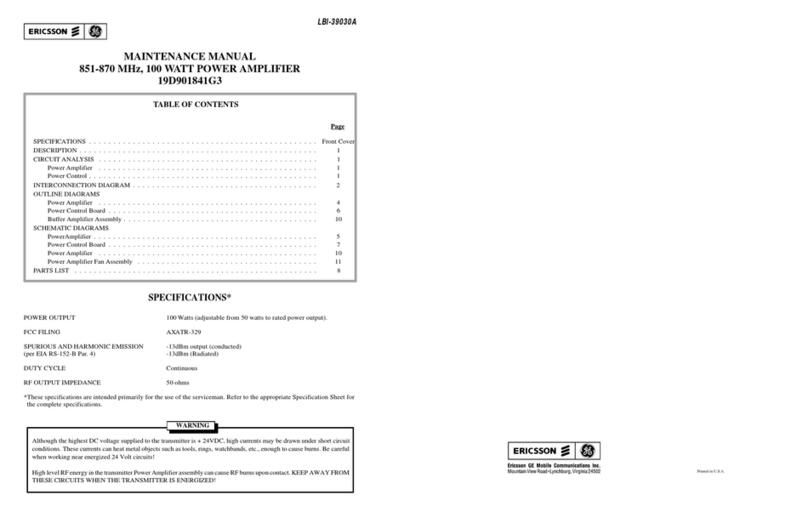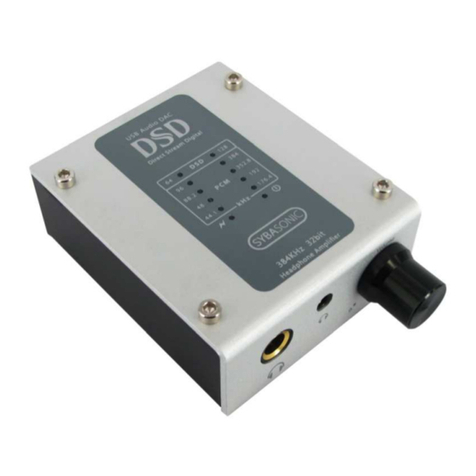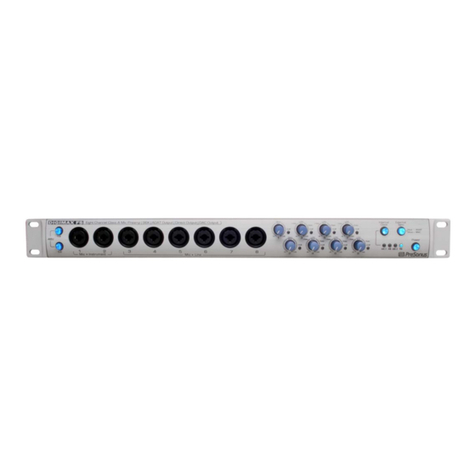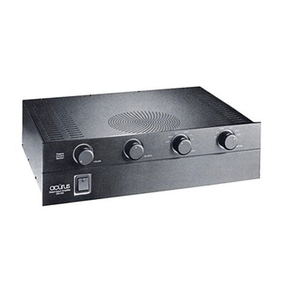PR electronic 2204 User manual

Programmable displays with a wide se-
lection of inputs and outputs for display of temperature,
volume and weight, etc. Feature linearisation, scaling,
and difference measurement functions for programming
via PReset software.
Interfaces for analogue and digital
signals as well as HART®signals between sensors / I/P
converters / frequency signals and control systems in Ex
zone 0, 1 & 2 and for some modules in zone 20, 21 & 22.
Galvanic isolators for analogue and digital
signals as well as HART®signals. A wide product range
with both loop-powered and universal isolators featuring
linearisation, inversion, and scaling of output signals.
PC or front programmable modules with
universal options for input, output and supply. This range
offers a number of advanced features such as process
calibration, linearisation and auto-diagnosis.
A wide selection of transmitters for DIN
form B mounting and DIN rail modules with analogue
and digital bus communication ranging from application-
specific to universal transmitters.
Displays
Temperature
Isolation
Ex interfaces
Universal
DK
UK
FR
DE
Side 1
Page 13
Page 25
Seite 37
SIGNALS THE BEST
2204
Isolation Amplifier
No. 2204V104-IN (0934)
From ser. no. 970205001

ISOLATIONSFORSTÆRKER
Type 2204
Indholdsfortegnelse
Advarsler . . . . . . . . . . . . . . . . . . . . . . . . . . . . . . . . . . . . . . 2
Sikkerhedsregler . . . . . . . . . . . . . . . . . . . . . . . . . . . . . . . . 3
EF-overensstemmelseserklæring . . . . . . . . . . . . . . . . . . . 5
Adskillelse af SYSTEM 2200. . . . . . . . . . . . . . . . . . . . . . . 6
Anvendelse . . . . . . . . . . . . . . . . . . . . . . . . . . . . . . . . . . . . 7
Teknisk karakteristik . . . . . . . . . . . . . . . . . . . . . . . . . . . . . 7
Indgang . . . . . . . . . . . . . . . . . . . . . . . . . . . . . . . . . . . . . . . 7
Udgang . . . . . . . . . . . . . . . . . . . . . . . . . . . . . . . . . . . . . . . 7
Elektriske specifikationer. . . . . . . . . . . . . . . . . . . . . . . . . . 8
Bestillingsskema . . . . . . . . . . . . . . . . . . . . . . . . . . . . . . . . 10
Blokdiagram . . . . . . . . . . . . . . . . . . . . . . . . . . . . . . . . . . . 10
Programmeringsskema . . . . . . . . . . . . . . . . . . . . . . . . . . . 11
1

SIKKERHEDSREGLER
DEFINITIONER:
Farlige spændinger er defineret som områderne: 75...1500 Volt DC og 50...1000
Volt AC.
Teknikere er kvalificerede personer, som er uddannet eller oplært til at kunne
udføre installation, betjening eller evt. fejlfinding både teknisk og sikkerheds-
mæssigt forsvarligt.
Operatører er personer, som under normal drift med produktet skal indstille og
betjene produktets trykknapper eller potentiometre, og som er gjort bekendt med
indholdet af denne manual.
MODTAGELSE OG UDPAKNING:
Udpak modulet uden at beskadige dette, og sørg for, at manualen altid følger
modulet og er tilgængelig. Indpakningen bør følge modulet, indtil dette er mon-
teret på blivende plads.
Kontrollér ved modtagelsen, at modultypen svarer til den bestilte.
MILJØFORHOLD:
Undgå direkte sollys, kraftigt støv eller varme, mekaniske rystelser og stød, og
udsæt ikke modulet for regn eller kraftig fugt. Om nødvendigt skal opvarmning,
udover de opgivne grænser for omgivelsestemperatur, forhindres ved hjælp af
ventilation.
Alle moduler hører til Installationskategori II, Forureningsgrad 1 og Isolations-
klasse II.
INSTALLATION:
Modulet må kun tilsluttes af teknikere, som er bekendte med de tekniske udtryk,
advarsler og instruktioner i manualen, og som vil følge disse.
Hvis der er tvivl om modulets rette håndtering, skal der rettes henvendelse til den
lokale forhandler eller alternativt direkte til:
PR electronics A/S, Lerbakken 10, DK-8410 Rønde tlf: +45 86 37 26 77.
Installation og tilslutning af modulet skal følge landets gældende regler for instal-
lation af elektrisk materiel bl. a. med hensyn til ledningstværsnit, for-sikring og
placering.
Beskrivelse af indgang / udgang og forsyningsforbindelser findes på blokdia-
grammet og sideskiltet.
32
ADVARSEL
Dette modul er beregnet for tilslutning til livsfarlige elektriske
spændinger. Hvis denne advarsel ignoreres, kan det føre til alvor-
lig legemsbeskadigelse eller mekanisk ødelæggelse.
For at undgå faren for elektriske stød og brand skal manualens
sikkerhedsregler overholdes, og vejledningerne skal følges.
De elektriske specifikationer må ikke overskrides, og modulet må
kun benyttes som beskrevet i det følgende.
Manualen skal studeres omhyggeligt, før modulet tages i brug.
Kun kvalificeret personale (teknikere) må installere dette modul.
Hvis modulet ikke benyttes som beskrevet i denne manual, så
forringes modulets beskyttelsesforanstaltninger.
ADVARSEL
Der må ikke tilsluttes farlig spænding til modulet, før dette er fast-
monteret, og følgende operationer på modulet bør kun udføres i
spændingsløs tilstand og under ESD-sikre forhold:
Adskillelse af modulet for indstilling af omskiftere og jumpere.
Installation, ledningsmontage og -demontage.
Fejlfinding på modulet.
Reparation af modulet og udskiftning af sikringer må kun
foretages af PR electronics A/S.
ADVARSEL
For at overholde sikkerhedsafstande må moduler med to indbyg-
gede relæer ikke tilsluttes både farlig og ikke-farlig spænding på
samme moduls relækontakter.
SYSTEM 2200 monteres i sokkel type S3B Releco (bestillings-
nummer 7023).
Trekant med udråbstegn: Advarsel / krav. Hændelser der kan
føre til livstruende situationer.
CE-mærket er det synlige tegn på modulets overensstemmelse
med direktivernes krav.
Dobbelt isolation er symbolet for, at modulet overholder ekstra
krav til isolation.
SIGNATURFORKLARING:
GENERELT
FARLIG
SPÆNDING
INSTAL-
LATION

5
EF-OVERENSSTEMMELSESERKLÆRING
Som producent erklærer
PR electronics A/S
Lerbakken 10
DK-8410 Rønde
hermed at følgende produkt:
Type: 2204
Navn: Isolationsforstærker
er i overensstemmelse med følgende direktiver og standarder:
EMC-direktivet 2004/108/EF og senere tilføjelser
EN 61326-1
For specifikation af det acceptable EMC-niveau henvises til modulets
elektriske specifikationer.
Lavspændingsdirektivet 2006/95/EF og senere tilføjelser
EN 61010-1
CE-mærket for overensstemmelse med lavspændingsdirektivet blev tilføjet i
året: 1997
Rønde, 29. september 2008 Peter Rasmussen
Producentens underskrift
For moduler, som er permanent tilsluttet farlig spænding, gælder:
For-sikringens maksimale størrelse er 10 A og skal sammen med en
afbryder placeres let tilgængelig og tæt ved modulet. Afbryderen skal
mærkes således, at der ikke er tvivl om, at den afbryder spændingen til
modulet.
KALIBRERING OG JUSTERING:
Under kalibrering og justering skal måling og tilslutning af eksterne spændinger
udføres i henhold til denne manual, og teknikeren skal benytte sikkerhedsmæs-
sigt korrekte værktøjer og instrumenter.
BETJENING UNDER NORMAL DRIFT:
Operatører må kun indstille eller betjene modulerne, når disse er fast installeret
på forsvarlig måde i tavler el. lignende, så betjeningen ikke medfører fare for liv
eller materiel. Dvs., at der ikke er berøringsfare, og at modulet er placeret, så det
er let at betjene.
RENGØRING:
Modulet må, i spændingsløs tilstand, rengøres med en klud let fugtet med destil-
leret vand.
ANSVAR:
I det omfang, instruktionerne i denne manual ikke nøje er overholdt, vil kunden
ikke kunne rette noget krav, som ellers måtte eksistere i henhold til den indgåede
salgsaftale, mod PR electronics A/S.
4

ISOLATIONSFORSTÆRKER 2204
• Indgang galvanisk adskilt fra udgang og forsyning
• Strøm- eller spændingsindgang
• Signalkonvertering
• Strøm- og spændingsudgang
• 24 VDC eller universelt forsynet
• Kan benyttes i PELV/SELV strømkredse
ANVENDELSE:
Galvanisk adskillelse af analoge signaler (ground loop eliminering). Måling af
ikke-stelbundne signaler. Signalkonvertering inden for områderne: 0...10 VDC
eller 0...50 mA på indgangen og 0...20 mA og 0...10 VDC i faste områder på
udgangen.
TEKNISK KARAKTERISTIK:
GENERELT:
2204 benytter mikroprocessorteknologi til valg af forstærkning og nulpunkts-
forskydning, men signalbehandlingen er analog med en hurtig reaktionstid på
under 25 ms.
For standardområder er 2204 programmerbar med interne dipswitche inden for
bestillingsskemaets ind- og udgangsområder, uden at dette kræver efterjustering,
forudsat at justeringer i front stadig er forseglede. Universelt forsynede enheder
har 3-port galvanisk adskillelse mellem indgang, forsyning og udgang.
INDGANG:
Strøm eller spænding i standardområde eller i specialudførelse inden for måle-
området. Standard indgangsspænding: 0/0,2...1 V, 0/0,5...2,5 V og 0/2...10 V. Ind-
gangsmodstand: typ. 10 MStandard indgangsstrøm: 0/1...5 mA eller 0/4...20
mA. Indgangsmodstand: nom. 50 (0/4...20 mA).
UDGANG:
Udgangen kan bestilles til standard strømme og spændinger eller i special-
udførelse inden for signalområdet.
7
ADSKILLELSE AF SYSTEM 2200
Billede 1:
Modulets bagplade frigøres fra huset
ved hjælp af en skruetrækker.
Billede 2:
Derefter kan bagpladen udtræk-
kes sammen med printet, men vær
opmærksom på printets placering
i huset, da det er muligt at isætte
dette i flere positioner. Træk ikke
unødigt i ledningerne, men tag fat
i printet.
Nu kan switche og jumpere ændres.
Det er vigtigt, at ingen ledninger
kommer i klemme, når bagplade og
huset samles.
6

9
Indgang:
Strøm:
Måleområde ................................................ 0...50 mADC
Min. måleområde (span).............................. 4 mADC
Max. nulpunktsforskydning......................... 20% af max. værdi
Indgangsmodstand ..................................... Nom. 50
Spænding:
Måleområde ................................................ 0...10 VDC
Min. måleområde (span).............................. 0,2 VDC
Max. nulpunktsforskydning......................... 20% af max. værdi
Indgangsmodstand ..................................... 10 M
Udgang:
Strømudgang:
Signalområder ............................................. 0...5 mA / 0...20 mA
Min. signalområde (span)............................ 4 / 16 mA
Max. nulpunktsforskydning......................... 20% af max. værdi
Belastning (max.)......................................... 20 mA / 600 / 12 VDC
Belastningsstabilitet .................................... < ±0,01% af span / 100
Strømbegrænsning...................................... 23...28 mA
Spændingsudgang via intern shunt:
Signalområder ............................................. 0...0,25V / 0...1V / 0...2,5V / 0...10 V
Min. signalområde (span)............................ 0,2 / 0,8 / 2,0 / 8,0 V
Max. nulpunktsforskydning......................... 20% af max. værdi
Belastning (min.).......................................... 500 k
Udgangsmodstand...................................... 50 / 500
GOST R godkendelse:
VNIIM, Cert. no............................................ Se www.prelectronics.dk
Overholdte myndighedskrav: Standard:
EMC 2004/108/EF....................................... EN 61326-1
LVD 2006/95/EF .......................................... EN 61010-1
PELV/SELV................................................... IEC 364-4-41 og EN 60742
Af span = Af det aktuelt valgte område
Standard strømudgang (ben 3) 0/4...20 mA og 0/1...5 mA efter bestillingsskema
med mulighed for reversering. Strømbegrænsning: 23...28 mA.
Standard spændingsudgang (ben 2) opnås ved at kortslutte ben 2 og 3.
Spændingssignalet udtages mellem ben 2 og 1. For spændingssignaler i området
0...1 VDC anvendes 50 shunt (DP 2-1), i området 0...10 VDC anvendes 500
shunt (DP 2-2).
Anvendes begge signaler samtidigt, skal mA-sløjfen til gnd. gennem den interne
shunt. Justering af 0 og 100% er tilgængelig i fronten ±10%, men vær opmærk-
som på, at grundkalibreringen dermed er tabt.
ELEKTRISKE SPECIFIKATIONER:
Specifikationsområde:
-20°C til +60°C
Fælles specifikationer:
Forsyningsspænding, DC............................ 19,2...28,8 VDC
Forsyningsspænding, universel................... 21,6...253 VAC, 50...60 Hz eller
19,2...300 VDC
Max. forbrug 2204--D (24 VDC).................. 1,3 W
Max. forbrug 2204--P (uni. forsynet)........... 1,8 W
Isolation, test / drift ..................................... 3,75 kVAC / 250 VAC
Signal- / støjforhold..................................... Min. 60 dB
Reaktionstid (0...90%)................................. < 25 ms
Temperaturkoefficient.................................. < ±0,01% af span/°C
Linearitetsfejl ............................................... < ±0,1% af span
Virkning af forsyningsspændings-
ændring ....................................................... < ±0,002% af span/%V
EMC-immunitetspåvirkning......................... < ±0,5% af span
Relativ luftfugtighed .................................... < 95% RH (ikke kond.)
Mål (HxBxD) ................................................ 80,5 x 35,5 x 84,5 mm
Kapslingsklasse........................................... IP50
Vægt DC / universelt forsynet..................... 110 g / 160 g
8

11
PROGRAMMERINGSSKEMA:
INDGANGS- DP1 (10-polet)
PROGRAMMERING SW 1, 2, 3, 4, 5
SW ON SW OFF
0...5 mA 1, 3 2, 4, 5
0...20 mA 1, 4 2, 3, 5
0...1 V 2, 3 1, 4, 5
0...2,5 V 2, 4 1, 3, 5
0...10 V 2, 3, 4 1, 5
Ved 20% offset på indgang,
indstil DP1 SW5 til ON
f.eks. indgang 4...20 mA 1, 4, 5 2, 3
UDGANGS- DP2 (4-polet) DP1 (10-polet)
PROGRAMMERING SW 1 - 4 SW 6, 7, 8, 9, 10
SW ON SW OFF ON OFF
0...5 mA 4 1, 2, 3 7 6, 8, 9, 10
0...20 mA 3 1, 2, 4 8 6, 7, 9, 10
0...5 mA / 0...250 mV 1, 4 2, 3 6 7, 8, 9, 10
0...20 mA / 0...1 V 1, 3 2, 4 6, 7 8, 9, 10
0...5 mA / 0...2,5 V 2, 4 1, 3 6, 8 7, 9, 10
0...20 mA / 0...10 V 2, 3 1, 4 6, 7, 8 9, 10
Ved 20% offset på udgang,
indstil DP1 SW9 til ON
f.eks. udgang 4...20 mA 3 1, 2, 4 8, 9 6, 7, 10
Ved reverseret udgang
indstil DP1, SW10 til ON
f.eks. udgang 20...4 mA 3 1, 2, 4 8, 9,10 6, 7
Bemærk: Ved andre span end ovennævnte har DP1 og DP2 en
anderledes indstilling, som gælder for det leverede specialområde.
10
BESTILLINGSSKEMA:
Type Indgang Udgang Forsyning
2204 0...20 mA : A
4...20 mA : B
0...1 V : C
0,2...1 V : D
0...10 V : E
2...10 V : F
Speciel : X
Speciel : 0
0...20 mA : 1
4... 20 mA : 2
0...5 mA : 3
0...1 V : 4
0,2...1 V : 5
0...10 V : 6
2...10 V : 7
24 VDC : D
24...230 VAC & : P
24...250 VDC
BLOKDIAGRAM:

ISOLATION AMPLIFIER
Type 2204
Contents
Warnings . . . . . . . . . . . . . . . . . . . . . . . . . . . . . . . . . . . . . . 14
Safety instructions. . . . . . . . . . . . . . . . . . . . . . . . . . . . . . . 16
EC Declaration of Conformity . . . . . . . . . . . . . . . . . . . . . . 18
How to dismantle SYSTEM 2200 . . . . . . . . . . . . . . . . . . . 19
Applications. . . . . . . . . . . . . . . . . . . . . . . . . . . . . . . . . . . . 20
Technical characteristics . . . . . . . . . . . . . . . . . . . . . . . . . . 20
Input . . . . . . . . . . . . . . . . . . . . . . . . . . . . . . . . . . . . . . . . . 20
Output . . . . . . . . . . . . . . . . . . . . . . . . . . . . . . . . . . . . . . . . 21
Electrical specifications. . . . . . . . . . . . . . . . . . . . . . . . . . . 21
Order . . . . . . . . . . . . . . . . . . . . . . . . . . . . . . . . . . . . . . . . . 23
Block diagram . . . . . . . . . . . . . . . . . . . . . . . . . . . . . . . . . . 23
Programming. . . . . . . . . . . . . . . . . . . . . . . . . . . . . . . . . . . 24
1312

15
SYMBOL IDENTIFICATION
Triangle with an exclamation mark: Warning / demand.
Potentially lethal situations.
The CE mark proves the compliance of the module with
the requirements of the directives.
The double insulation symbol shows that the module is
protected by double or reinforced insulation.
14
WARNING!
This module is designed for connection to hazardous electric
voltages. Ignoring this warning can result in severe personal
injury or mechanical damage.
To avoid the risk of electric shock and fire, the safety instructions
of this manual must be observed and the guidelines followed.
The electrical specifications must not be exceeded, and the
module must only be applied as described in the following.
Prior to the commissioning of the module, this manual must be
examined carefully.
Only qualified personnel (technicians) should install this module.
If the equipment is used in a manner not specified by the
manufacturer, the protection provided by the equipment may
be impaired.
WARNING!
Until the module is fixed, do not connect hazardous voltages to
the module. The following operations should only be carried out
on a disconnected module and under ESD safe conditions:
Dismantlement of the module for setting of dipswitches
and jumpers.
General mounting, connection and disconnection of wires.
Troubleshooting the module.
Repair of the module and replacement of circuit breakers
must be done by PR electronics A/S only.
WARNING!
To keep the safety distances, modules with two built-in relays
must not be connected to both hazardous and non-hazardous
voltages on the same module’s relay contacts.
SYSTEM 2200 must be mounted in socket type S3B Releco
(order no 7023).
GENERAL
HAZARD-
OUS
VOLTAGE
INSTAL-
LATION

The following apply to fixed hazardous voltages-connected modules:
The max. size of the protective fuse is 10 A and, together with a power
switch, it should be easily accessible and close to the module. The
power switch should be marked with a label telling it will switch off the
voltage to the module.
CALIBRATION AND ADJUSTMENT:
During calibration and adjustment, the measuring and connection of external
voltages must be carried out according to the specifications of this manual.
The technician must use tools and instruments that are safe to use.
NORMAL OPERATION:
Operators are only allowed to adjust and operate modules that are safely fixed in
panels, etc., thus avoiding the danger of personal injury and damage. This means
there is no electrical shock hazard, and the module is easily accessible.
CLEANING:
When disconnected, the module may be cleaned with a cloth moistened with
distilled water.
LIABILITY:
To the extent the instructions in this manual are not strictly observed, the
customer cannot advance a demand against PR electronics A/S that would
otherwise exist according to the concluded sales agreement.
17
SAFETY INSTRUCTIONS
DEFINITIONS:
Hazardous voltages have been defined as the ranges: 75 to 1500 Volt DC, and
50 to 1000 Volt AC.
Technicians are qualified persons educated or trained to mount, operate, and
also troubleshoot technically correct and in accordance with safety regulations.
Operators, being familiar with the contents of this manual, adjust and operate the
knobs or potentiometers during normal operation.
RECEIPT AND UNPACKING:
Unpack the module without damaging it and make sure that the manual always
follows the module and is always available. The packing should always follow the
module until this has been permanently mounted.
Check at the receipt of the module whether the type corresponds to the one
ordered.
ENVIRONMENT:
Avoid direct sunlight, dust, high temperatures, mechanical vibrations and shock,
as well as rain and heavy moisture. If necessary, heating in excess of the stated
limits for ambient temperatures should be avoided by way of ventilation.
All modules fall under Installation Category II, Pollution Degree 1, and Insulation
Class II.
MOUNTING:
Only technicians who are familiar with the technical terms, warnings, and
instructions in the manual and who are able to follow these should connect the
module.
Should there be any doubt as to the correct handling of the module, please
contact your local distributor or, alternatively,
PR electronics A/S, Lerbakken 10, DK-8410 Rønde,
Denmark, tel: +45 86 37 26 77.
Mounting and connection of the module should comply with national legislation
for mounting of electric materials, i.a. wire cross section, protective fuse, and
location. Descriptions of Input / Output and supply connections are shown in the
block diagram and side label.
16

HOW TO DISMANTLE SYSTEM 2200
Picture 1:
The back panel of the module is
detached from the housing by way
of a screw-driver.
Picture 2:
After this, the back panel can be
pulled out together with the PCB,
but please notice the position of
the PCB as there is a number of
different positions in the house. Do
not pull the wires unnecessarily,
instead pull the PCB.
Switches and jumpers can now be
moved.
When assembling the back plate
and housing, please make sure no
wires are stuck.
19
EC DECLARATION OF CONFORMITY
As manufacturer
PR electronics A/S
Lerbakken 10
DK-8410 Rønde
hereby declares that the following product:
Type: 2204
Name: Isolation amplifier
is in conformity with the following directives and standards:
The EMC Directive 2004/108/EC and later amendments
EN 61326-1
For specification of the acceptable EMC performance level, refer to the
electrical specifications for the module.
The Low Voltage Directive 2006/95/EC and later amendments
EN 61010-1
The CE mark for compliance with the Low Voltage directive was affixed in the
year: 1997
Rønde, 29 September 2008 Peter Rasmussen
Manufacturer’s signature
18

OUTPUT:
The output can be ordered for standard currents and voltages or special
versions within the signal range.
Standard output current (pin 3) 0/4...20 mA and 0/1...5 mA acc. to order
schedule with the possibility of reversal. Current limit: 23...28 mA.
Standard voltage output (pin 2) is achieved by short-circuiting pins 2 and 3. The
current signal is available between pins 2 and 1. For voltage signals in the range
0...1 VDC, a 50 shunt (DP 2-1) is applied; in the range 0...10 VDC, a 500
shunt (DP 2-2) is applied. If both signals are used simultaneously, the mA loop to
ground must go through the internal shunt. Adjustment of 0 and 100% is possible
in the front ±10%, but please note that the basic calibration is thereby lost.
ELECTRICAL SPECIFICATIONS:
Specifications range:
-20°C to +60°C
Common specifications:
Supply voltage, DC ..................................... 19.2...28.8 VDC
Supply voltage, universal ............................ 21.6...253 VAC, 50...60 Hz or
19.2...300 VDC
Max. consumption 2204--D (24 VDC)......... 1.3 W
Max. consumption 2204--P (uni. supply).... 1.8 W
Isolation, test / operation ............................ 3.75 kVAC / 250 VAC
Signal / noise ratio ...................................... Min. 60 dB
Response time (0...90%)............................. < 25 ms
Temperature coefficient............................... < ±0.01% of span/°C
Linearity error .............................................. < ±0.1% of span
Effect of supply voltage change.................. < ±0.002% of span/%V
EMC immunity influence ............................ < ±0.5% of span
Relative air humidity.................................... < 95% RH (non cond.)
Dimensions (HxWxD)................................... 80.5 x 35.5 x 84.5 mm
Protection degree........................................ IP50
Weight DC / universally supplied ................ 110 g / 160 g
21
ISOLATION AMPLIFIER 2204
• Input galvanically separated from output and supply
• Current or voltage input
• Signal conversion
• Current and voltage output
• 24 VDC supply or universally supplied
• Applicable in PELV/SELV circuits
APPLICATIONS:
Galvanic separation of analogue signals (ground loop elimination).
Measurement of floating signals. Signal conversion within the ranges: 0...10
VDC or 0...50 mA on the input and 0...20 mA and 0...10 VDC in fixed ranges on the
output.
TECHNICAL CHARACTERISTICS:
GENERAL:
The 2204 uses microprocessor technology for the selection of gain and zero
offset, yet the signal conditioning is analogue with a fast response time of less
than 25 ms.
In standard ranges, the 2204 is programmable by use of internal dipswitches
within the input and output ranges of the order schedule. Provided that front
adjustments are still sealed, the unit needs no adjustment after programming.
Universally supplied units have a 3-port galvanic separation between input,
supply, and output.
INPUT:
Current or voltage in standard or special ranges within the measuring range.
Standard input voltage: 0/0.2...1 V, 0/0.5...2.5 V and 0/2...10 V.
Input resistance: typ. 10 M.
Standard input current: 0/1...5 mA or 0/4...20 mA.
Input resistance: norm. 50 (0/4...20 mA).
20

23
ORDER:
BLOCK DIAGRAM:
Input:
Current:
Measurement range .................................... 0...50 mADC
Min. measurement range (span).................. 4 mADC
Max. offset................................................... 20% of max. value
Input resistance........................................... Nom. 50
Voltage:
Measurement range .................................... 0...10 VDC
Min. measurement range (span).................. 0.2 VDC
Max. offset................................................... 20% of max. value
Input resistance........................................... 10 M
Output:
Current output:
Signal ranges............................................... 0...5 mA / 0...20 mA
Min. measurement range (span).................. 4 mA / 16 mA
Max. offset................................................... 20% of max. value
Load (max.).................................................. 20 mA / 600 / 12 VDC
Load stability............................................... < ±0.01% of span / 100
Current limit................................................. 23...28 mA
Voltage output through internal shunt:
Signal ranges............................................... 0...0.25V / 0...1V / 0...2.5V / 0...10V
Min. measurement range (span).................. 0.2 V / 0.8 V / 2.0 V / 8.0 V
Max. offset................................................... 20% of max. value
Load (min.)................................................... 500 k
Output resistance........................................ 50 / 500
GOST R approval:
VNIIM, Cert. no............................................ See www.prelectronics.com
Observed authority requirements: Standard:
EMC 2004/1086/EC .................................... EN 61326-1
LVD 2006/95/EC.......................................... EN 61010-1
PELV/SELV................................................... IEC 364-4-41 and EN 60742
Of span = Of the presently selected range
22
Type Input Output Supply
2204 0...20 mA : A
4...20 mA : B
0...1 V : C
0.2...1 V : D
0...10 V : E
2...10 V : F
Special : X
Special : 0
0...20 mA : 1
4...20 mA : 2
0...5 mA : 3
0...1 V : 4
0.2...1 V : 5
0...10 V : 6
2...10 V : 7
24 VDC : D
24...230 VAC & : P
24...250 VDC

CONVERTISSEUR A ISOLATION
GALVANIQUE
Type 2204
Sommaire
Avertissements . . . . . . . . . . . . . . . . . . . . . . . . . . . . . . . . . 26
Consignes de sécurité. . . . . . . . . . . . . . . . . . . . . . . . . . . . 28
Déclaration de conformité CE. . . . . . . . . . . . . . . . . . . . . . 30
Démontage du SYSTEME 2200 . . . . . . . . . . . . . . . . . . . . 31
Applications. . . . . . . . . . . . . . . . . . . . . . . . . . . . . . . . . . . . 32
Caractéristiques techniques . . . . . . . . . . . . . . . . . . . . . . . 32
Entrée . . . . . . . . . . . . . . . . . . . . . . . . . . . . . . . . . . . . . . . . 32
Sortie . . . . . . . . . . . . . . . . . . . . . . . . . . . . . . . . . . . . . . . . . 33
Spécifications électriques . . . . . . . . . . . . . . . . . . . . . . . . . 33
Référence de commande . . . . . . . . . . . . . . . . . . . . . . . . . 35
Schéma de principe . . . . . . . . . . . . . . . . . . . . . . . . . . . . . 35
Configuration. . . . . . . . . . . . . . . . . . . . . . . . . . . . . . . . . . . 36
2524
PROGRAMMING:
INPUT DP1 (10-pole)
PROGRAMMING SW 1, 2, 3, 4, 5
SW ON SW OFF
0...5 mA 1, 3 2, 4, 5
0...20 mA 1, 4 2, 3, 5
0...1 V 2, 3 1, 4, 5
0...2.5 V 2, 4 1, 3, 5
0...10 V 2, 3, 4 1, 5
For 20% offset on input,
set DP1 SW5 ON
e.g. input 4...20 mA 1, 4, 5 2, 3
OUTPUT DP2 (4-pole) DP1 (10-pole)
PROGRAMMING SW 1 - 4 SW 6, 7, 8, 9, 10
SW ON SW OFF ON OFF
0...5 mA 4 1, 2, 3 7 6, 8, 9, 10
0...20 mA 3 1, 2, 4 8 6, 7, 9, 10
0...5 mA / 0...250 mV 1, 4 2, 3 6 7, 8, 9, 10
0...20 mA / 0...1 V 1, 3 2, 4 6, 7 8, 9, 10
0...5 mA / 0...2.5 V 2, 4 1, 3 6, 8 7, 9, 10
0...20 mA / 0...10 V 2, 3 1, 4 6, 7, 8 9, 10
For 20% offset on output,
set DP1 SW9 ON
e.g. output 4...20 mA 3 1, 2, 4 8, 9 6, 7, 10
For reversed output set DP1,
SW10 ON e.g. output 20...4 mA 3 1, 2, 4 8, 9, 10 6, 7
Note: At other spans than the above-mentioned, DP1 and DP2 have a different
setting which applies to the delivered special range.

27
SIGNIFICATION DES SYMBOLES
Triangle avec point d’exclamation : Attention ! Si vous ne
respectez pas les instructions, la situation pourrait être fatale.
Le signe CE indique que le module est conforme aux
exigences des directives.
Ce symbole indique que le module est protégé par une
isolation double ou renforcée.
26
AVERTISSEMENT !
Ce module est conçu pour supporter une connexion à des
tensions électriques dangereuses. Si vous ne tenez pas compte
de cet avertissement, cela peut causer des dommages corporels
ou des dégâts mécaniques.
Pour éviter les risques d’électrocution et d’incendie, conformez-
vous aux consignes de sécurité et suivez les instructions
mentionnées dans ce guide. Vous devez vous limiter aux
spécifications indiquées et respecter les instructions d’utilisation
de ce module, telles qu’elles sont décrites dans ce guide.
Il est nécessaire de lire ce guide attentivement avant de mettre
ce module en marche. L’installation de ce module est réservée à
un personnel qualifié (techniciens). Si la méthode d’utilisation de
l’équipement diffère de celle décrite par le fabricant, la protection
assurée par l’équipement risque d’être altérée.
AVERTISSEMENT !
Tant que le module n’est pas fixé, ne connectez pas de tensions
dangereuses. Les opérations suivantes doivent être effectuées
avec le module débranché et dans un environnement exempt de
décharges électrostatiques (ESD) : démontage du module pour
régler les commutateurs DIP et les cavaliers, montage général,
raccordement et débranchement de fils et recherche de pannes
sur le module.
Seule PR electronics SARL est autorisée à réparer le module
et à remplacer les disjoncteurs.
AVERTISSEMENT !
Afin de conserver les distances de sécurité, les modules à
deux relais intégrés ne doivent pas être mis sous tensions
dangereuses et non dangereuses sur les mêmes contacts du
relais du module.
Il convient de monter l’appareil SYSTEM 2200 sur un support du
type S3B Releco (numéro de référence 7023).
INFORMA-
TIONS
GENERALES
TENSION
DANGE-
REUSE
INSTAL-
LATION

Les connexions des alimentations et des entrées / sorties sont décrites dans le
schéma de principe et sur l’étiquette de la face latérale du module.
Les instructions suivantes s’appliquent aux modules fixes connectés en tensions
dangereuses :
Le fusible de protection doit être de 10 A au maximum. Ce dernier,
ainsi que l’interrupteur général, doivent être facilement accessibles et
à proximité du module. Il est recommandé de placer sur l’interupteur
général une étiquette indiquant que ce dernier mettra le module hors
tension.
ETALONNAGE ET REGLAGE
Lors des opérations d’étalonnage et de réglage, il convient d’effectuer les
mesures et les connexions des tensions externes en respectant les spécifications
mentionnées dans ce guide.
Les techniciens doivent utiliser des outils et des instruments pouvant être
manipulés en toute sécurité.
MANIPULATIONS ORDINAIRES
Les opérateurs sont uniquement autorisés à régler et faire fonctionner des
modules qui sont solidement fixés sur des platines des tableaux, ect., afin
d’écarter les risques de dommages corporels. Autrement dit, il ne doit exister
aucun danger d’électrocution et le module doit être facilement accessible.
MAINTENANCE ET ENTRETIEN
Une fois le module hors tension, prenez un chiffon humecté d’eau distillée pour
le nettoyer.
LIMITATION DE RESPONSABILITE
Dans la mesure où les instructions de ce guide ne sont pas strictement
respectées par le client, ce dernier n’est pas en droit de faire une réclamation
auprès de PR electronics SARL, même si cette dernière figure dans l’accord de
vente conclu.
29
CONSIGNES DE SECURITE
DEFINITIONS
Les gammes de tensions dangereuses sont les suivantes : de 75 à 1500 Vcc et de
50 à 1000 Vca. Les techniciens sont des personnes qualifiées qui sont capables
de monter et de faire fonctionner un appareil, et d’y rechercher les pannes, tout
en respectant les règles de sécurité. Les opérateurs, connaissant le contenu de
ce guide, règlent et actionnent les boutons ou les potentiomètres au cours des
manipulations ordinaires.
RECEPTION ET DEBALLAGE
Déballez le module sans l’endommager. Le guide doit toujours être disponible
et se trouver à proximité du module. De même, il est recommandé de conserver
l’emballage du module tant que ce dernier n’est pas définitivement monté. A la
réception du module, vérifiez que le type de module reçu correspond à celui que
vous avez commandé.
ENVIRONNEMENT
N’exposez pas votre module aux rayons directs du soleil et choisissez un endroit
à humidité modérée et à l’abri de la poussière, des températures élevées, des
chocs et des vibrations mécaniques et de la pluie. Le cas échéant, des systèmes
de ventilation permettent d’éviter qu’une pièce soit chauffée au-delà des limites
prescrites pour les températures ambiantes.
Tous les modules appartiennent à la catégorie d’installation Il, au degré de
pollution 1 et à la classe d’isolation Il.
MONTAGE
Il est conseillé de réserver le raccordement du module aux techniciens qui
connaissent les termes techniques, les avertissements et les instructions de ce
guide et qui sont capables d’appliquer ces dernières.
Si vous avez un doute quelconque quant à la manipulation du module, veuillez
contacter votre distributeur local. Vous pouvez également vous adresser à PR
electronics SARL, Zac du Chêne, Activillage, 4, allée des Sorbiers, F-69673 Bron
Cedex (tél.: (0) 472 140 607) ou à PR electronics A/S, Lerbakken 10, DK-8410
Rønde, Danemark (tél.:+45 86 37 26 77).
Le montage et le raccordement du module doivent être conformes à la législation
nationale en vigueur pour le montage de matériaux électriques, par exemple,
diamètres des fils, fusibles de protection et implantation des modules.
28

DEMONTAGE DU SYSTEME 2200
Figure 1 :
A l’aide d’un tournevis, dégagez la face
arrière du module du boîtier.
Figure 2 :
Vous pouvez maintenant extraire la face
arrière du module ainsi que la carte
à circuits imprimés. Veuillez repérer
la position de cette carte car il existe
de nombreuses positions possibles
dans le boîtier. Lorsque vous
extrayez la carte à circuits imprimés,
tirez sur celle-ci et évitez de tirer
sur les fils. Vous pouvez maintenant
déplacer les commutateurs et les
cavaliers. Lorsque vous assemblez
la face arrière du module et le boîtier,
veuillez vérifier que les fils ne sont
pas coincés.
31
DECLARATION DE CONFORMITE CE
En tant que fabricant
PR electronics A/S
Lerbakken 10
DK-8410 Rønde
déclare que le produit suivant :
Type : 2204
Nom : Convertisseur à isolation galvanique
correspond aux directives et normes suivantes :
La directive CEM (EMC) 2004/108/CE et les modifications subséquentes
EN 61326-1
Pour une spécification du niveau de rendement acceptable CEM (EMC)
renvoyer aux spécifications électriques du module.
La directive basse tension 2006/95/CE et les modifications subséquentes
EN 61010-1
La marque CE pour conformité avec la directive basse tension a été apposée
en 1997
Rønde, le 29 septembre 2008 Peter Rasmussen
Signature du fabricant
30

Entrée tension max. : 10 Vcc.
Echelle minimale : 200 mVcc.
Entrée courant max. : 50 mA.
Echelle minimale : 4 mA.
Décalage max du zéro : 20%.
SORTIE :
Sortie courant ou tension disponible en gammes standard selon la table de
programmation ou selon vos spécifications. Noter qu’il est possible d’inverser la
sortie (par ex. 20...4 mA).
Sortie courant standard 0/4...20 mA et 0/1...5 mA.
Le signal de courant est pris entre les borniers 3 et 1.
La sortie tension est obtenue entre les borniers 1 et 2 en court-circuitant les
borniers 2 et 3. Pour les signaux de tension appartenant aux gammes de 0...1
Vcc et de 0...10 Vcc, des shunts de 50 (DP 2-1) et de 500 (DP 2-2) sont
respectivement sélectionnés. A partir de la face avant de l’appareil, vous pouvez
effectuer un réglage spécifique à votre application de ±10% de l’échelle aux
potentiomètres 0 et 100%, mais veuillez remarquer que l’étalonnage initial sera
alors perdu.
Spécifications électriques :
Plage des spécifications :
20°C à +60°C
Spécifications communes :
Tension d’alimentation, cc........................... 19,2...28,8 Vcc
Tension d’alimentation, universelle ............. 21,6...253 Vca, 50...60 Hz ou
19,2...300 Vcc
Consom. max. 2204--D (24 Vcc) ................ 1,3 W
Consom. max. 2204--P (alim. uni.) ............. 1,8 W
Tension d’isolation, test / opération............ 3,75 kVca / 250 Vca
Rapport signal / bruit .................................. 60 dB min.
Temps de réponse (0...90%) ....................... < 25 ms
Coefficient de température.......................... < ±0,01% de l’EC/°C
Erreur de linéarité ........................................ < ±0,1% de l’EC
Effet d’une variation de la tension d’alim.... < ±0,002% de l’EC/%V
CEM (EMC) : Effet de l’immunité ................ < ±0,5% de l’EC
Humidité relative.......................................... < 95% HR (sans cond.)
Dimensions (HxLxP) .................................... 80,5 x 35,5 x 84,5 mm
Degré de protection .................................... IP50
Poids cc / alim. universelle ......................... 110 g / 160 g
33
CONVERTISSEUR A ISOLATION
GALVANIQUE 2204
• Entrée isolée galvaniquement de la sortie et
de l’alimentation
• Conversion de signaux
• Entrée tension ou courant
• Sortie tension et courant
• Alimentation 24 Vcc ou universelle
• Utilisable dans les circuits PELV/SELV
APPLICATIONS :
Isolation galvanique de signaux analogiques (élimination de boucles de masse).
Mesure de signaux flottants. Conversion de signaux de tension et courant
comprise entre 0 et 10 Vcc et entre 0 et 50 mA en signaux de courant ou tension
dans les gammes de 0...10 Vcc ou de 0...20 mA (par ex. une conversion de 0...1
Vcc en 4...20 mA).
CARACTÉRISTIQUES TECHNIQUES :
GÉNÉRALITÉS :
Le microprocesseur intégré au module 2204 permet de sélectionner le gain et le
décalage du zéro sans effectuer de réétalonnage. Cependant, le traitement des
signaux est analogique avec un temps de réponse rapide inférieur à 25 ms.
Dans les gammes standard, vous pouvez configurer le module 2204 en réglant
les commutateurs internes selon les gammes d’entrée et de sortie indiquées dans
la table de programmation. A condition que les potentiomètres soient toujours
protégés par une pastille intacte, il n’est pas nécessaire de régler l’appareil une
fois la configuration terminée. La version avec alimentation universelle dispose
d’une triple isolation galvanique (entrée / sortie / alimentation), et la version
alimentée en 24 Vcc a une entrée qui est isolée galvaniquement de la sortie et
de l’alimentation.
ENTREE :
Entrée courant ou tension disponible en gammes standard selon la table de
programmation. Vous pouvez également spécifier à la commande une entrée
courant ou tension en gammes spéciales :
32

35
REFERENCE DE COMMANDE :
Type Entrée Sortie Alimentation
2204 0...20 mA : A
4...20 mA : B
0...1 V : C
0,2...1 V : D
0...10 V : E
2...10 V : F
Spéciale : X
Spéciale : 0
0...20 mA : 1
4...20 mA : 2
0...5 mA : 3
0...1 V : 4
0,2...1 V : 5
0...10 V : 6
2...10 V : 7
24 Vcc : D
24...230 Vca & : P
24...250 Vcc
SCHEMA DE PRINCIPE :
34
Entrée
Courant :
Gamme de mesure...................................... 0...50 mAcc
Plage de mesure min. ................................. 4 mAcc
Decalage du zéro ........................................ 20% de la valeur max.
Impédance d’entrée .................................... Nom. 50
Tension :
Gamme de mesure...................................... 0...10 Vcc
Plage de mesure min. ................................. 0,2 Vcc
Decalage du zéro ........................................ 20% de la valeur max.
Impédance d’entrée .................................... 10 M
Sortie :
Sortie courant :
Gammes de mesure.................................... 0...5 mA / 0...20 mA
Plages de mesure min................................. 4 mA / 16 mA
Decalage du zéro ........................................ 20% de la valeur max.
Charge (max.) .............................................. 20 mA / 600 / 12 Vcc
Stabilité sous charge................................... < ±0,01% de l’EC / 100
Limite de courant ........................................ 23...28 mA
Sortie tension :
Gammes de mesure.................................... 0...0,25V / 0...1V / 0...2,5V / 0...10V
Plages de mesure min................................. 0,2 V / 0,8 V / 2,0 V / 8,0 V
Decalage du zéro ........................................ 20% de la valeur max.
Charge (min.) ............................................... 500 k
Résistance de sortie.................................... 50 / 500
Approbation GOST R :
VNIIM, Cert. no............................................ Voir www.prelectronics.fr
Agréments et homologations : Standard :
CEM (EMC) 2004/108/CE ........................... EN 61326-1
DBT 2006/95/CE ......................................... EN 61010-1
PELV/SELV................................................... IEC 364-4-41 et EN 60742
EC = Echelle configurée

TRENNVERSTÄRKER
TYP 2204
Inhaltsverzeichnis
Warnung . . . . . . . . . . . . . . . . . . . . . . . . . . . . . . . . . . . . . . 38
Sicherheitsregeln. . . . . . . . . . . . . . . . . . . . . . . . . . . . . . . . 40
EG-Konformitätserklärung. . . . . . . . . . . . . . . . . . . . . . . . . 42
Zerlegung des SYSTEMs 2200 . . . . . . . . . . . . . . . . . . . . . 43
Anwendung . . . . . . . . . . . . . . . . . . . . . . . . . . . . . . . . . . . . 44
Technische Merkmale . . . . . . . . . . . . . . . . . . . . . . . . . . . . 44
Eingang . . . . . . . . . . . . . . . . . . . . . . . . . . . . . . . . . . . . . . . 44
Ausgang . . . . . . . . . . . . . . . . . . . . . . . . . . . . . . . . . . . . . . 44
Elektrische Daten . . . . . . . . . . . . . . . . . . . . . . . . . . . . . . . 45
Bestellangaben . . . . . . . . . . . . . . . . . . . . . . . . . . . . . . . . . 47
Blockdiagramm . . . . . . . . . . . . . . . . . . . . . . . . . . . . . . . . . 47
Programmierung . . . . . . . . . . . . . . . . . . . . . . . . . . . . . . . . 48
3736
CONFIGURATION :
ENTREE DP1 (10-pôles)
SW 1, 2, 3, 4, 5
SW ON SW OFF
0...5 mA 1, 3 2, 4, 5
0...20 mA 1, 4 2, 3, 5
0...1 V 2, 3 1, 4, 5
0...2,5 V 2, 4 1, 3, 5
0...10 V 2, 3, 4 1, 5
Pour 20% décalage du zéro,
mettez DP1-5 sur ON
Ex. entrée 4...20 mA 1, 4, 5 2, 3
SORTIE DP2 (4-pôles) DP1 (10-pôles)
SW 1 - 4 SW 6, 7, 8, 9, 10
SW ON SW OFF ON OFF
0...5 mA 4 1, 2, 3 7 6, 8, 9, 10
0...20 mA 3 1, 2, 4 8 6, 7, 9, 10
0...5 mA / 0...250 mV 1, 4 2, 3 6 7, 8, 9, 10
0...20 mA / 0...1 V 1, 3 2, 4 6, 7 8, 9, 10
0...5 mA / 0...2,5 V 2, 4 1, 3 6, 8 7, 9, 10
0...20 mA / 0...10 V 2, 3 1, 4 6, 7, 8 9, 10
Pour 20% décalage du zéro,
mettez DP1-9 sur ON
Ex. sortie 4...20 mA 3 1, 2, 4 8, 9 6, 7, 10
Pour sortie inversée,
mettez DP1-10 sur ON
Ex. sortie 20...4 mA 3 1, 2, 4 8, 9,10 6, 7
NB : Pour des gammes spéciales, DP1 et DP2 ont une configuration
qui n’est pas dans le schéma ci-dessus.
Table of contents
Languages:


